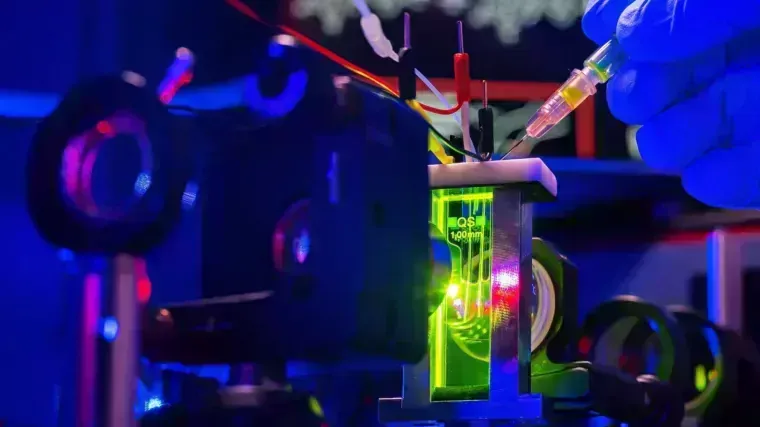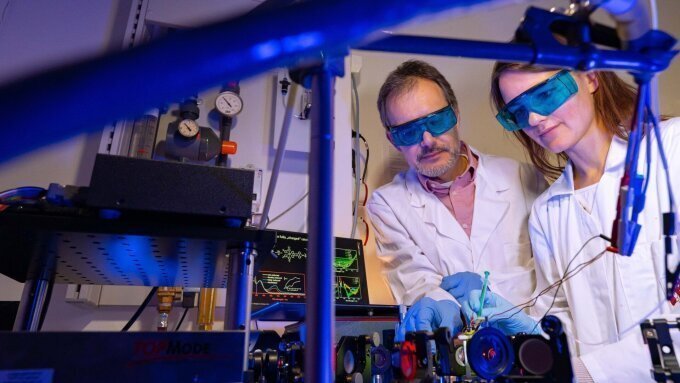
- Light
Published: | By: Uta Schönfelder, English translation by Gleb Chupakhin
A research team from the Institute of Physical Chemistry at the University of Jena and the Leibniz Institute of Photonic Technology has achieved the feat of making the invisible visible. Through newly developed spectroscopic methods, the researchers can observe the processes occurring in photocatalysis with unprecedented temporal resolution and precision. ACP principal scientist Prof. Dr. Benjamin Dietzek-Ivanšić, Dr. Linda Zedler, and Dr. Carolin Müller have been awarded this year's Thuringian Research PrizeExternal link in the Applied Research category for their groundbreaking work. The prize, endowed with 25,000 euros, was presented on April 19th at the University of Jena by Minister of Science Wolfgang Tiefensee.
Prof. Dietzek-Ivanšić expresses his delight about the award bestowed upon his team: "This is a great motivator for further collaboration with colleagues from the Collaborative Research Center 'CataLight' to gain new insights into the functioning of molecular photocatalysts." Teammate Dr. Linda Zedler sees the recognition "as the crowning achievement of a long and challenging journey for a fantastic team."
Energy Production as Modeled by Nature
Meeting the growing energy demand of humanity sustainably and in the long-term can only be achieved through renewable energy sources. Solar energy plays a central role in the renewable energy mix. Therefore, researchers worldwide are searching for new ways to harness solar energy. "Nature shows us how it can be done", says Prof. Dietzek-Ivanšić. Trees and other green plants utilize the energy of sunlight through photosynthesis. Natural light-absorbing molecules called photocatalysts play a role in this process: they capture the energy and use it to synthesize energy-rich molecules. This process converts CO2 and light into glucose and oxygen within the plant.
While the molecular processes of photosynthesis are well understood, the development of catalysts for light energy conversion remains challenging, particularly in the field of physical chemistry, which provides methods and tools to understand the structure and functionality of such catalysts. This is where the work of Dietzek-Ivanšić and his team, who have now been honored with the Thuringian Research Prize, begins. "In particular, we want to investigate how light absorption occurs in the intermediates of photocatalytic reactions and what chemical rearrangements it leads to," explains Dietzek-Ivanšić. This question has been inadequately answered so far. "Only when these fundamental mechanisms are elucidated can we selectively adjust catalysts and reaction conditions to develop more efficient photocatalytic systems."
New Insights into Light-Driven Processes
The researchers have developed two experimental methods, namely "time-resolved absorption spectroelectrochemistry" and "in operando absorption spectroscopy," which allow for the precise observation of extremely short-lived intermediates and the progress of photocatalytic reactions for the first time.
For "time-resolved absorption spectroelectrochemistry," the researchers combined two methods from different areas of material characterization: electrochemistry and time-resolved optical spectroscopy. In this approach, the molecules of interest are electrically "charged", meaning chemically oxidized or reduced. The prepared molecules exhibit the same chemical properties as the intermediates in photocatalytic processes, but they are more long-lived and can accumulate in higher concentrations within the specially designed electrochemical cell. As a result, they become more accessible for subsequent optical spectroscopy, enabling a detailed examination of light-induced processes and structural rearrangements within the molecules.
The "in operando absorption spectroscopy" also allows for the practical observation of chemically unstable photocatalysts "in action". In this method, photocatalysis is initiated by light irradiation, and absorption experiments are performed at different times during the ongoing processes. This approach provides researchers with snapshots that depict the progression of catalysis at various stages.
Dr. Linda Zedler und Prof. Dr. Benjamin Dietzek-Ivanšić in the laboratory.
Image: Jens Meyer (University of Jena)